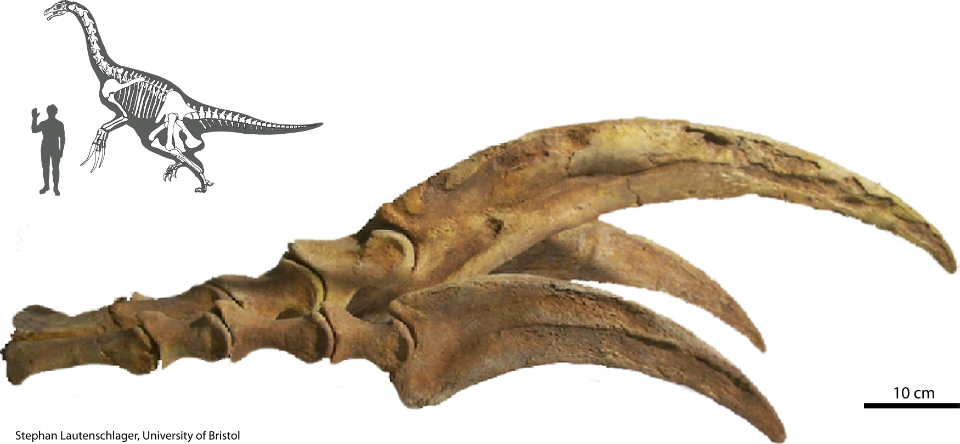ADVERTISEMENT
Filtered By: Scitech
SciTech
T. rex claws may have been for digging, not tearing
By MACY AÑONUEVO

Illustration showing different therizinosaur claw shapes and their adaptation to specific functions.
Therapod dinosaurs—a group made famous by Tyrannosaurus rex and Velociraptor—are generally thought of as dangerous carnivores, with sharp claws on their fingers and toes and equally sharp teeth for chowing down and tearing flesh. But a new look at the claws of other therapods shows that they could have been used for other things aside from cutting into prey.
Dr. Stephan Lautenschlager from Bristol's School of Earth Sciences focused his research on the therizinosaurs, a subgroup of therapods that lived 145 to 66 million years ago. Previous studies on the shape of their teeth and jaws suggested that unlike other therapods, therizinosaurs were herbivores. They were also quite large, reaching up to 7 meters tall and with large claws up to 90 cm long on their fingers. A close relative of modern-day birds, therizinosaurs were covered by a coast of primitive, down-like feathers and had hollow bones.


This is a fossil of the enlarged claws on the forelimbs of the therapod dinosaur, Therizinosaurus cheloniformes. A new study by Dr. Stephan Lautenschlager of the University of Bristol, UK, reveals that, during their transition from carnivores to herbivores, therapod dinosaurs developed a large variety of claw shapes adapted to specific functions such as digging, grasping, or piercing.
In a paper published online in the Proceedings of the Royal Society, Dr Lautenschlager said: "Theropod dinosaurs were all bipedal, which means their forelimbs were no longer involved in walking as in other dinosaurs. This allowed them to develop a whole new suite of claw shapes adapted to different functions."
Computer models were developed to simulate the possible functions of the different claws of different species. Dinosaur claws were also compared to the claws of modern mammals whose uses are known. Results showed that, as they evolved, the therizinosaurs became herbivores and developed the appropriate claws for digging, grasping, or piercing.
Dr Lautenschlager said: "It's fascinating to see that, with the shift from a carnivorous to a plant-based diet, we find a large variety of claw shapes adapted to different functions. This suggests that dietary adaptations were an important driver during the evolution of theropod dinosaurs and their transition to modern birds." — TJD, GMA News
Macy Añonuevo earned her MS Marine Science degree from the University of the Philippines. She is a published science and travel writer and was a finalist in the 2013 World Responsible Tourism Awards under the Best Photography for Responsible Tourism category. Her writings and photographs may be found at www.theislandergirl.com.
Macy Añonuevo earned her MS Marine Science degree from the University of the Philippines. She is a published science and travel writer and was a finalist in the 2013 World Responsible Tourism Awards under the Best Photography for Responsible Tourism category. Her writings and photographs may be found at www.theislandergirl.com.
More Videos
Most Popular




